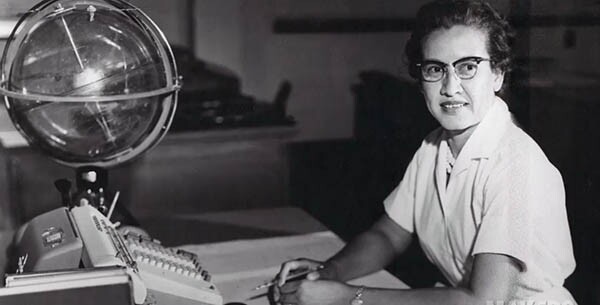Journalists boost book and movie telling black women mathematicians’ story
DOI: 10.1063/PT.5.8189
The Washington Post occasionally circulates email under the heading “The Optimist: Stories that inspire.” A recent such message gave first billing to an article

Katherine Johnson.
NASA
A promotional web page
Back in 1986, aerospace historian James R. Hansen—known later for First Man, the only Neil Armstrong biography crafted with full access to Armstrong and his papers—summarized those beginnings in Engineer in Charge
They hired hundreds of boys for part-time work as shop assistants, messengers, and [wind tunnel] model makers, and encouraged mathematics and English teachers from the local school systems to capitalize on their summer vacations by taking positions as computers and technical report editors. Many of the teachers chose to stay on at Langley permanently because their new jobs with the government were more interesting, paid better, had more fringe benefits, and related more concretely to the war effort than teaching school.
Women in numbers came to work at Langley for the first time, many of them to do jobs formerly done only by men. Before the war the lab had never employed more than 100 women at one time, mostly for traditional office functions as secretaries, stenographers, typists, mail sorters, payroll and file clerks, telephone operators, and receptionists. The exception to the rule was Pearl I. Young (1895-1968), the NACA’s first female professional. A Phi Beta Kappa graduate in physics from the University of North Dakota, Young reported to work at Langley in April 1922. Her first assignment was in the Instrument Research Division, where she worked side-by-side with Henry Reid, [Langley’s] future engineer-in-charge....
In some respects, Pearl Young led the way for working women at Langley. By war’s end, nearly 1000 women worked at Langley—practically one-half of the nonprofessional staff and one-third of the entire staff. The majority of the women continued to do the quiet, unspectacular jobs involved in keeping the wheels of the government laboratory running smoothly through the welter of paperwork, but many of them rolled up their sleeves, donned shop aprons, and pitched in to do whatever work had been made necessary for them by the war. Women set rivets, operated spray guns and welding irons, polished wind tunnel models, and drove buses and trucks around the field. Others served as technical illustrators and draftsmen. One woman drove the towing carriage in the hydrodynamics research tank. The Structures Division, which operated its own training school, assigned women to take strain-gauge measurements. Female computing units (one of them made up entirely of black women) were added to several of the individual wind tunnel staffs. These distaff units took over most of the slide rule work and curve plotting formerly done by the engineers. Only a few women held engineering posts, and they were not assigned to the wind tunnels. A number of females with the rating of “minor laboratory apprentice” were used, however, as mechanics’ helpers to relieve hard-pressed junior engineers of many duties associated with tunnel operation and laboratory procedure. On the whole, the women who worked at Langley during and after World War II could not advance as far or as fast up the civil service ladder as could even some men with inferior talents; nonetheless, most of them still believe today that the NACA’s treatment of women was better than the treatment of women by many other contemporary employers.
As the 3-minute movie trailer
That promotional statement emphasizes that the African American women involved “were nearly all top graduates of historically black colleges such as Hampton Institute [now Hampton University], Virginia State and Wilberforce University.” Then the statement shows part of why their story lends itself to dramatization:
Though they did the same work as the white women hired at the time, they were cloistered away in their own segregated office.... But despite the hardships of working under ... Jim Crow laws, these women went on to make significant contributions to aeronautics, astronautics, and America’s victory over the Soviet Union in the Space Race.
Space.com quoted
This is “a movie that is very much on the surface about the early years of NASA and getting a man into space,” said Jim Parsons, who plays a fictional NASA engineer named Paul Stafford in the film. “And it highlights three people who, because they were women and because they were African American, didn’t get the credit they deserved for their input or contribution to this. So really, what we’re doing here is a civil-rights-slash-feminist movie—and that’s what’s so wonderful about being here, and so exciting to be a part of.”
Parsons means Dorothy Vaughan, Mary Jackson, and Katherine Johnson. Vaughan
As a computer, she calculated the trajectory for Alan Shepard, the first American in space. Even after NASA began using electronic computers, John Glenn requested that she personally recheck the calculations made by the new electronic computers before his flight aboard Friendship 7—the mission on which he became the first American to orbit the Earth. She continued to work at NASA until 1986 combining her math talent with electronic computer skills. Her calculations proved as critical to the success of the Apollo Moon landing program and the start of the Space Shuttle program, as they did to those first steps on the country’s journey into space.
The highly positive media coverage of Hidden Figures extends from the Wall Street Journal
Even the toymaker Lego feels it in the spirit of the times. Lego is considering
---
Steven T. Corneliussen, a media analyst for the American Institute of Physics, monitors three national newspapers, the weeklies Nature and Science, and occasionally other publications. He has published op-eds in the Washington Post and other newspapers, has written for NASA’s history program, and was a science writer at a particle-accelerator laboratory.



